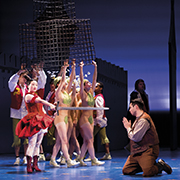The first performance of Jean-Philippe Rameau’s Comédie-Ballet „Les Paladins“ was a failure from which the work did not recover for a long time. Today it strikes us as a jewel with many opportunities for presentation on the stage.
Initially called Le Vénitien, and probably intended for court in the late 1750s, Jean-Philippe Rameau’s Les Paladins was finally performed in February 1760 at the Académie royale de musique in Paris and was his last composition. Despite its propitious programming during carnival, the work only received about a dozen performances and it remained one of the most bitter failures of the composer’s career. It was not performed again until the 20th century. Yet today, it is difficult to understand its frosty reception from contemporary audiences in view of the wealth of musical treasures and stylistic innovations it contains, following the example of Les Boréades.
A comédie-ballet in three acts to an anonymous libretto attributed to Pierre-Jacques Duplat de Monticourt, Les Paladins is based on La Fontaine’s fable “Le Petit chien qui secoue de l’argent et des pierreries”. Set in a fictitious medieval Venetia, the tutor Anselme thwarts the amorous adventures of his ward Argie. The overtly comic libretto, which cast a sidelong glance at Molieresque comedy, Italian theatre and opéra-comique, confused the audience. The libretto was criticised above all for its mixture of tragic and comic genres. In fact the librettist of Les Paladins had fun juxtaposing contrasting sequences ranging from serious tragedy (Argie’s monologue, infernal scene) to popular comedy (Orcan’s seduction scene); the sexually ambiguous fairy Manto finally brought about the work’s downfall, which was too bold for the Paris Opéra.
The sources seem to confirm that the opera was composed in the mid-1750s, so it is certainly plausible to read Les Paladins as Rameau’s musical answer to the debates which raged around Paris during the time of the Querelle des Bouffons. Rameau maintained his silence during the dispute (apart from responding to Rousseau’s Lettre sur la musique française). With Les Paladins he suggested a new model of opera. Particular elements, such as the abandonment of the magical and the mythological for realistic intrigue, the comic treatment of certain dramatic situations and the light string orchestration are reminiscent of the Italian style, and are added to French traditions, such as the danced divertissements, the tragic monologue, the birdsong aria and the infernal scene. All these heterogeneous elements merge and create a hybrid form, close in sound to opéra-comique, but which is neither entirely Italian nor entirely French, and could therefore satisfy both camps.
Unlike the traditional structure of French opera libretti with mainly rather short roles, the text of Les Paladins requires four main roles of similar extent, all with a well-defined personality. These were performed by the best singers in the Opéra ensemble, Argie and Atis respectively by Mlle Arnoult and M. Lombard; Nérine and Orcan by Mlle Lemière and M. Larrivée. The best dancers (Lany, Lyonnois and Vestris) from the Opéra excelled equally in the ballets with their incredible rhythmic inventiveness and most sumptuous orchestration, reminiscent of the orchestral boldness of Les Boréades. After Rameau had completed the score, the appointment of tenured horn players in the Opéra orchestra led him to revise his writing in long sections of the work to give more prominence to the sound of these instruments.
In general, during the course of the performances Rameau considerably revised Les Paladins, seeking to respond to public criticism. The critical edition which I have prepared as part of the Opera omnia Rameau contains the final version of the work as authorised by the composer at the end of the series of performances in March 1760, complemented by several appendices which enable the first version to be performed as was originally envisaged for the court. During Rameau’s lifetime Les Paladins remained unpublished, and the work was not included in the Œuvres complètes published by Durand. This is therefore the first edition, one which fulfils both scholarly criteria and the practical requirements of musicians.
- Thomas Soury
- (from “[t]akte” 1/2019 – translation: Elizabeth Robinson)



